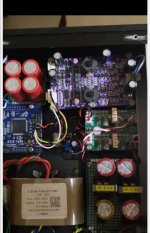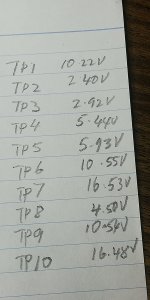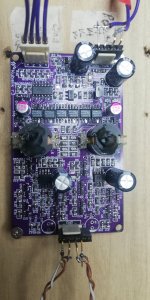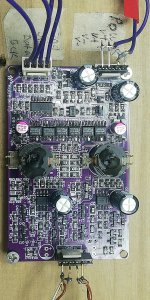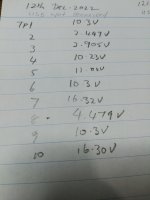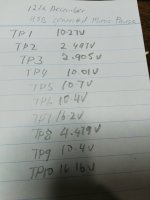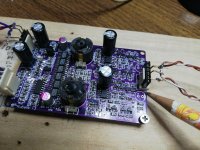@commstech, Out of curiosity, do you use exactly same output caps on both DACs in comparison? I tried some pio-caps on my kubelik and when putting back electrolytics I felt that the sound became more "flat", less "3D". On some records its like the singer has taken a step back.Sorry for the delay and thanks to Abraxalito for his patience. Finally settled down from some life and work matters and have some free time to write. As a background, I have Kubelik with opamp in the IV/output stage. Abraxalito, please correct me if i am wrong -- Kubelik has discrete transistors biased in class A at the outputs, in combination of Op amp stages. Recently, i received a new version with full discrete IV/output stage, which is now called Dorati. Kubelik works on 20Vdc and Dorati works on 15Vdc max, which prompted me to get a new transformer.
Upon firing up Dorati, the immediate impression is a more quieter and dark background. This is a very obvious difference from the Kubelik. This could be due to a less demanding power supply? I am using the same psu regulation on both dac. The Dorati presented a more solid imaging when i played Chinese orchestra music. More pin-point positions of the various instruments. I can feel that there is more depth in the soundstaging presented by Dorati as compared to Kubelik. To be more specific, there is more depth and space.
I played female vocals and listened. Again, the above observations. However, i feel that the singer actually took a couple steps back as compared to Kubelik. Instruments are more widely spaced apart, more resolution for Dorati - which sometimes i feel the Kubelik may slightly lack in when i compare it to my Soekris r2r dac. The Dorati does sound more extended in the frequencies when strings are played, better decay than Kubelik.
At this point of time, one may think the Dorati is a clear cut above the Kubelik. I will say no. The Kubelik has a quality that i like very much. It has more ambience to the music. It adds warmth and bloom especially in the mid and low regions. When complex passages like the Chinese Orchestra is playing, the Kubelik may not produce the bigger soundstage and separation of Dorati but let me say that the Kubelik has a very good control of the music - unfazed, there is no nervousness. The Dorati has a certain small degree of strain whenever i really push up the volume playing the orchestra, while the Kubelik has no sweat at all. This is something that the Kubelik impressed me since day one.
In general, the Kubelik has a more upfront and forward presentation versus the more backward and bigger presentation of the Dorati. the Dorati plays with more finesse, finer resolution , more hi-fi style. Kubelik is about warmth and control, good grip and bite on complex passages. I do believe the different output stages work done by Abraxalito attribute to a strong influence on the sonic outcome on the same dac implementation. I do believe both designs can work well on different systems and the individual's taste.
I hope this helps.
Hello yes, basically only the transformers are changed. All else remain the same. Output caps are black gate non polarized. Variables need to be kept constant for a proper comparison.@commstech, Out of curiosity, do you use exactly same output caps on both DACs in comparison? I tried some pio-caps on my kubelik and when putting back electrolytics I felt that the sound became more "flat", less "3D". On some records its like the singer has taken a step back.
I had only a low value pio to try and indeed bass was compromised, therefore I returned the electrolytic but I preferred much the sound of the pio. I have ordered 10uF pio caps and will see if it will be sufficient for acceptable bass. If not, then i will test with one pio and one electrolytic in parallel.@Chri12 what value of pio cap are u using? It is going to be a fat ***.
From my experiment, using a pio cap alone with appropriate value is going to be challenging in terms of practicality. I have tried big fat mkp 10uf and huge *** 20uf Siemens oil cap on Kubelik and I am not satisfied with the bass. With a minimum of 47uf non polarized electrolytic caps, I get the bass I am satisfied with. I wish I can get a 47uf mkp cap that can fit into my chassis but in my case, is not possible now . Perhaps I should have taken this Dac more seriously right from the start and plan for huge film caps.I had only a low value pio to try and indeed bass was compromised, therefore I returned the electrolytic but I preferred much the sound of the pio. I have ordered 10uF pio caps and will see if it will be sufficient for acceptable bass. If not, then i will test with one pio and one electrolytic in parallel.
Is the bass response from the Dorati similar to Kubelik or would the Dorati allow for a smaller capacitor without loosing bass? I think I read somewhere that the Kubelik is a bit more modest in the low end compared to the Deca dac.From my experiment, using a pio cap alone with appropriate value is going to be challenging in terms of practicality. I have tried big fat mkp 10uf and huge *** 20uf Siemens oil cap on Kubelik and I am not satisfied with the bass. With a minimum of 47uf non polarized electrolytic caps, I get the bass I am satisfied with. I wish I can get a 47uf mkp cap that can fit into my chassis but in my case, is not possible now . Perhaps I should have taken this Dac more seriously right from the start and plan for huge film caps.
Unlike the Kubelik, I have not done any adventure with different output caps value with Dorati yet. But i think it is worth trying it out some day.Is the bass response from the Dorati similar to Kubelik or would the Dorati allow for a smaller capacitor without loosing bass? I think I read somewhere that the Kubelik is a bit more modest in the low end compared to the Deca dac.
take a look ad DC-link caps ....From my experiment, using a pio cap alone with appropriate value is going to be challenging in terms of practicality. I have tried big fat mkp 10uf and huge *** 20uf Siemens oil cap on Kubelik and I am not satisfied with the bass. With a minimum of 47uf non polarized electrolytic caps, I get the bass I am satisfied with. I wish I can get a 47uf mkp cap that can fit into my chassis but in my case, is not possible now . Perhaps I should have taken this Dac more seriously right from the start and plan for huge film caps.
Could you be a bit more specific - what exactly would you recommend?take a look ad DC-link caps ....
Kubelik r3. Developed a fault after playing well for a few months.
The output from left channel is much much lower compared to right channel. When not playing music, there is an intermittent scratching sound.
Attachments are my build and TP measurement.
Hope to rectify problem with some help
The output from left channel is much much lower compared to right channel. When not playing music, there is an intermittent scratching sound.
Attachments are my build and TP measurement.
Hope to rectify problem with some help
Attachments
From looking at your list of TP voltages, the first problem seems to be between TP4 and TP6. These are on the R channel so I'm at a loss to understand how its the L channel which has the low signal condition.
First I would check the resistance across R61, could be its too low impedance due to a failure or short across C25.
What would be useful would be to have TP4 - TP7 taken again but with an active I2S input (music or silence playing out).
First I would check the resistance across R61, could be its too low impedance due to a failure or short across C25.
What would be useful would be to have TP4 - TP7 taken again but with an active I2S input (music or silence playing out).
These are new measurements.
Left channel referred to is this side of pcb. The side nearer to i2s input
In circuit R61 and R 41 resistors measures 1093 ohms for both
Left channel referred to is this side of pcb. The side nearer to i2s input
In circuit R61 and R 41 resistors measures 1093 ohms for both
Attachments
Prior to these measurements, l removed C9 and redo the soldering. There is no short at c25 and C 24
- Home
- Vendor's Bazaar
- Kubelik NOS DAC kits
